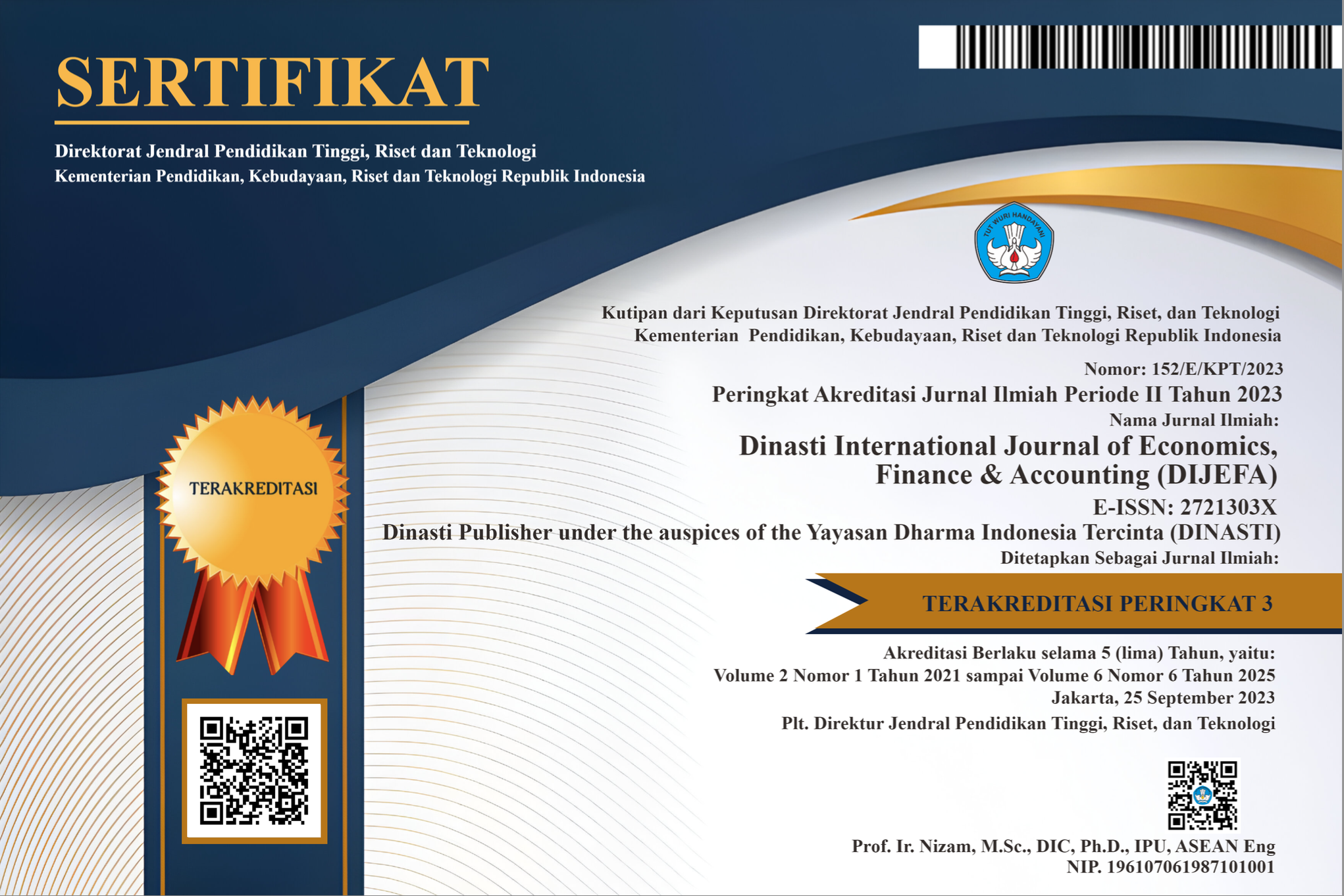Strategies for Improving Inventory Turnover at PT PK Manufacturing Indonesia
DOI:
https://doi.org/10.38035/dijefa.v6i2.4488Keywords:
Inventory Management, Inventory Turnover, Supply Chain Efficiency, Inventory Optimization, Operational EfficiencyAbstract
The objective of this study is to examine the factors influencing inventory turnover at PT PK Manufacturing Indonesia and to develop methods for improving inventory management efficiency. This research employs a qualitative approach, incorporating observations, interviews, and document analysis conducted at the research site, which includes the company’s warehouse and production facilities. The study aims to provide in-depth insights into the factors affecting inventory turnover and offer strategic recommendations for optimizing inventory management. Ultimately, this research will contribute to strategic management studies by presenting an effective approach to inventory management. The findings of this study are expected to benefit PT PK Manufacturing Indonesia and serve as a guideline for other manufacturing companies facing inventory turnover challenges.
References
Astuti, D. W., & Satiman. (2024). Pengaruh perputaran persediaan, perputaran piutang, dan total hutang terhadap laba bersih. Jurnal Ilmiah Research and Development Student (JIS), 2(1).
Braun, V., & Clarke, V. (2006). Using thematic analysis in psychology. Qualitative Research in Psychology, 3(2), 77–101. https://doi.org/10.1191/1478088706qp063oa
Bryman, A. (2016). Social research methods (5th ed.). Oxford University Press.
Chen, I. J., & Paulraj, A. (2004). Towards a theory of supply chain management. Journal of Operations Management, 22, 119–150. https://doi.org/10.1016/j.jom.2003.12.005
Chopra, S., & Meindl, P. (2022). Supply chain management: Strategy, planning, and operation (8th ed.). Pearson.
Christopher, M. (2016). Logistics & supply chain management (5th ed.). Pearson.
Creswell, J. W., & Poth, C. N. (2018). Qualitative inquiry and research design: Choosing among five approaches (4th ed.). SAGE Publications.
Denzin, N. K., & Lincoln, Y. S. (2018). The SAGE handbook of qualitative research (5th ed.). SAGE Publications.
Fisher, M. L. (1997). What is the right supply chain for your product? Harvard Business Review, 75(2), 105–116.
Flick, U. (2018). An introduction to qualitative research (6th ed.). SAGE Publications.
Gunasekaran, A., Patel, C., & Tirtiroglu, E. (2001). Performance measures and metrics in a supply chain environment. International Journal of Operations & Production Management, 21(1/2), 71–87. https://doi.org/10.1108/01443570110358468
Hamzah, A., Najib, M., & Rosadian, A. (2021). Analisis manajemen persediaan barang dagang pada Koperasi Wanita Petra (Studi kasus Coop Mart Pertamina RU-III Plaju) periode 2014-2016. Jurnal Manajemen dan Investasi (MANIVESTASI), 3(2), 285–306.
Ivanov, D., Dolgui, A., Sokolov, B., Ivanova, M., & Liu, S. (2016). A dynamic model and an algorithm for short-term supply chain scheduling in the smart factory industry 4.0. International Journal of Production Research, 54(2), 386–402. https://doi.org/10.1080/00207543.2018.1444806
Ivanov, D., Tsipoulanidis, A., & Schönberger, J. (2016). Global supply chain and operations management: A decision-oriented introduction to the creation of value (2nd ed.). Springer.
Jonsson, P., & Mattsson, S. A. (2008). Inventory management practices and their implications on perceived planning performance. International Journal of Production Research, 46(7), 1787–1812. https://doi.org/10.1080/00207540600902262
Joseph, F. K., Ubani, E. C., Kelechi, N. C., & Omeonu, O. M. (2023). Effect of inventory management. Asian Journal of Economics, Business and Accounting, 23(19), 9–23.
Kumar, A., Singh, R. K., & Shankar, R. (2020). Critical success factors for Industry 4.0 implementation in supply chains. Resources, Conservation and Recycling, 153, 104527. https://doi.org/10.1016/j.resconrec.2019.104527
Maulani, S. S., Jane, S., Rahayu, S. P., Pangisti, I. R., & Firly, A. (2024, Oktober 19). Literatur review: Perspektif implementasi sistem manajemen persediaan pada perusahaan manufaktur di Indonesia. SENMABIS – Seminar Nasional Manajemen dan Bisnis.
Merriam, S. B., & Tisdell, E. J. (2016). Qualitative research: A guide to design and implementation (4th ed.). Jossey-Bass.
Monk, E., & Wagner, B. (2013). Concepts in enterprise resource planning (4th ed.). Cengage Learning.
Ohno, T. (1988). Toyota production system: Beyond large-scale production. Productivity Press.
Patton, M. Q. (2015). Qualitative research & evaluation methods (4th ed.). SAGE Publications.
Shingo, S. (1989). A study of the Toyota production system: From an industrial engineering viewpoint. Productivity Press.
Simchi-Levi, D., Kaminsky, P., & Simchi-Levi, E. (2021). Designing and managing the supply chain (4th ed.). McGraw-Hill.
Van der Vorst, J. G., & Beulens, A. J. (2002). Identifying sources of uncertainty to generate supply chain redesign strategies. International Journal of Physical Distribution & Logistics Management, 32(6), 409–430.
Vollmann, T. E., Berry, W. L., Whybark, D. C., & Jacobs, F. R. (2005). Manufacturing planning and control for supply chain management (5th ed.). McGraw-Hill.
Waters, D. (2019). Inventory control and management (3rd ed.). Wiley.
Womack, J. P., & Jones, D. T. (1996). Lean thinking: Banish waste and create wealth in your corporation. Free Press.
Xu, L. D., Xu, E. L., & Li, L. (2018). Industry 4.0: State of the art and future trends. International Journal of Production Research, 56(8), 2941–2962. https://doi.org/10.1080/00207543.2018.1444806
Yin, R. K. (2018). Case study research and applications: Design and methods (6th ed.). SAGE Publications.
Downloads
Published
How to Cite
Issue
Section
License
Copyright (c) 2025 Mariyana Mariyana, R. Luki Karunia

This work is licensed under a Creative Commons Attribution 4.0 International License.
Authors who publish their manuscripts in this journal agree to the following conditions:
- The copyright on each article belongs to the author(s).
- The author acknowledges that the Dinasti International Journal of Economics, Finance & Accounting (DIJEFA) has the right to be the first to publish with a Creative Commons Attribution 4.0 International license (Attribution 4.0 International (CC BY 4.0).
- Authors can submit articles separately, arrange for the non-exclusive distribution of manuscripts that have been published in this journal into other versions (e.g., sent to the author's institutional repository, publication into books, etc.), by acknowledging that the manuscript has been published for the first time in the Dinasti International Journal of Economics, Finance & Accounting (DIJEFA).


























































